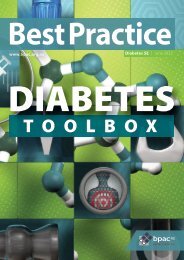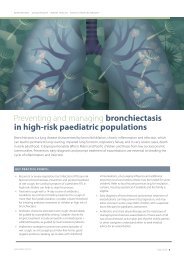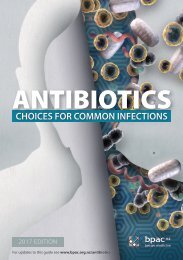Create successful ePaper yourself
Turn your PDF publications into a flip-book with our unique Google optimized e-Paper software.
Primary care monitoring of unexplained haematuria<br />
Primary care surveillance of unexplained haematuria requires<br />
annual assessment of urine dipstick, serum creatinine and<br />
urinary ACR, or urinary PCR. This should be conducted until<br />
two consecutive negative urinalyses occur. 12 Patients with<br />
stable CKD should be monitored according to their stage of<br />
disease. Refer patients back to urology if haematuria persists,<br />
or urinary tract symptoms develop or increase.<br />
For further information see: “The detection and<br />
management of patients with chronic kidney disease in primary<br />
care”, https://bpac.org.nz/BPJ/2015/February/ckd.aspx<br />
Cystoscopy is recommended to exclude bladder<br />
cancer<br />
Cystoscopy is the preferred technique for excluding bladder<br />
cancer as the cause of haematuria as it has a specificity for<br />
malignancy of over 90%, although it is a subjective and<br />
invasive tool that may miss flat lesions. * 14, 15<br />
Urine cytology<br />
is a non-invasive method, however it is not a “rule-out” test<br />
due to modest sensitivity which may be 30% for low-grade<br />
tumours. 15<br />
Urine cytology is not routinely recommended for the<br />
investigation of asymptomatic microscopic haematuria but is<br />
recommended for the investigation of macroscopic haematuria<br />
or symptomatic microscopic haematuria. 15 Urine cytology<br />
results are dependent on operator skill and it is important to<br />
have an experienced pathologist interpret the results. 16<br />
* Fluore<strong>sce</strong>nt, or blue light, cystoscopy is associated with a higher rate of<br />
lesion detection than standard white light cystoscopy<br />
Proteinuria on dipstick<br />
Persistent proteinuria is a marker for kidney disease and<br />
kidney disease progression, and of increased cardiovascular<br />
risk. 17 Urine dipstick mainly detects albumin and is relatively<br />
insensitive to non-albumin proteins, e.g. free light chains,<br />
haemoglobin and tubular proteins, although, the level of<br />
protein can be estimated from the result: 18<br />
Trace = 150–300 mg/L<br />
1+ = 300–1000 mg/L<br />
2+ = 1-3 g/L<br />
3+ = >3g/L<br />
A urine dipstick reading of +1 has a 94–96% specificity for<br />
detecting significant proteinuria. 19 The sensitivity of the test<br />
for detecting significant proteinuria ranges from 46–81%. 19 In<br />
people diagnosed with, or suspected of having diabetes the<br />
more sensitive ACR is recommended to quantify proteinuria. 17<br />
Proteinuria on dipstick is frequently an incidental finding<br />
and is often benign and transient, e.g. due to stress, illness<br />
or vigorous exercise. 18 However, the presence of proteinuria<br />
may also suggest endothelial/glomerular injury. The first step<br />
in assessment should be to consider the possibility of a false<br />
positive result, which can be caused by alkaline urine (pH >7),<br />
gross haematuria, leukocytes or the use of iodinated contrast<br />
18, 20<br />
agents.<br />
Confirm persistent proteinuria<br />
Proteinuria may be transient or persistent. Transient, mild<br />
proteinuria can be caused by exercise, standing for long<br />
periods (orthostatic proteinuria), pregnancy, UTI and acute<br />
febrile illness. 18 Orthostatic proteinuria is typically absent in the<br />
morning, occurs in the afternoon and is seen mainly in young<br />
adults and usually resolves in 10–20 years. 18 Congestive heart<br />
failure is a more serious cause of proteinuria that can also be<br />
transient.<br />
Persistent proteinuria can be confirmed by multiple<br />
positive results over one to two weeks. 20 If persistent proteinuria<br />
is present on dipstick, an ACR or PCR should precisely quantify<br />
the level (Figure 2). ACR is the preferred method as it has greater<br />
sensitivity than PCR for low concentrations of protein, and<br />
albumin is the predominant protein excreted in the majority<br />
of proteinuric kidney diseases. 21 Spot (random) urine samples<br />
are generally sufficient, although early morning collection is<br />
preferable as the sample will be more concentrated. 18<br />
Follow-up investigations of confirmed proteinuria<br />
If proteinuria and non-visible haematuria is present, a sample<br />
should be sent for urine microscopy. 3 Red blood cell casts<br />
and dysmorphic red blood cells are likely to be caused by<br />
glomerular disease. 3<br />
Renal function should be assessed and serum electrolytes<br />
requested. 23 Patients should be referred to nephrology<br />
regardless of the level of proteinuria if they have progressive<br />
CKD and an eGFR < 45 mL/min/1.73 m 2 or there is evidence<br />
of intrinsic kidney disease, e.g. glomerulonephritis, polycystic<br />
kidney disease or interstitial nephritis. 17 Patients with<br />
proteinuria who are not referred to nephrology should have<br />
blood pressure, urinalysis and renal function assessed every<br />
six to 12 months. 24<br />
Further information on diagnosing and managing CKD is<br />
available from: “The detection and management of patients<br />
with chronic kidney disease in primary care” , https://bpac.org.<br />
nz/BPJ/2015/February/ckd.aspx<br />
Request further testing if multiple myeloma is suspected<br />
Suspicion of multiple myeloma should be increased in patients<br />
aged over 60 years with bone pain or fractures, and fatigue<br />
and recurrent infections, with or without hypercalcaemia. 25<br />
There may also be laboratory evidence of anaemia and renal<br />
impairment. 25 Protein dipstick is inappropriate to exclude<br />
multiple myeloma due to its inability to detect light-chain<br />
50 Best Practice Journal – SCE Issue 1 www.bpac.org.nz









